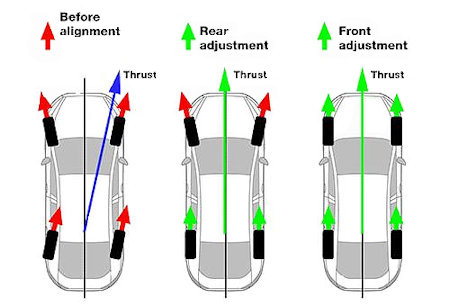


Mobile users:
For best results, view in Landscape mode.

Wheel Alignment refers to an
adjustment of a car's suspension.
The thrust angle (as shown in the
diagram above) is an imaginary line
drawn perpendicular to the rear axle's center-line.
It compares the direction that the rear axle is
aimed with.
Looking at a car from above, you would draw the
thrust line
perpendicular to the rear axle.
This identifies the direction in which the
rear wheels want to roll.
If the thrust angle aims to the
right, this is called a positive
thrust angle.
If the thrust angle aims to the left, this is
negative thrust angle.
A positive thrust angle will try to steer the
vehicle to the left, while a
negative thrust angle will try to steer the vehicle
to the right.
Wheel alignment is
also referred to as tracking.
It is not an adjustment of the tires or the wheels
themselves.
The key to proper alignment is adjusting the angles
of the tires
which affects how they make contact
with the road.
Three basic angles contribute to
proper wheel alignment:
camber, caster, and toe.
Camber is
the angle of the front tires when viewed from the
front of the car.
When the angle of the tire slants away from vertical
in either
direction, it can be a sign of misalignment.
When your car's
suspension and all of the steering components are
lined up and straight, the wheels are aligned.
Even so, it's a good idea to have your alignment checked
once a
year.
Getting a tire rotation at the same time is also
recommended.
Your mechanic will
typically recommend doing the wheel
alignment every 2 - 3 years.
The wheel alignment is also recommended when new tires
are installed.
If you experience any of
the following problems, check
with your mechanic for an alignment inspection:
You hear unusual noises in your suspension system.
The car is pulling to the right or left when traveling in a straight line
or when braking.
You feel vibration in the steering wheel or through your vehicle's
seat.
You haven't had a wheel alignment in a long period of time.
Your tires are wearing unevenly.
Squealing tires on turns.
The steering wheel does not return easily after a turn.
Correct alignment is critical
to safely controlling your vehicle,
braking stability, extending tire life, and ensuring a
comfortable
ride.

